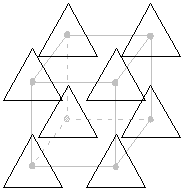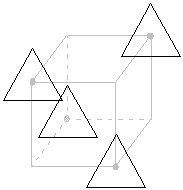When you generate a "complete" mixture-process variable design, the mixture design is generated at each combination of levels of the process variables. This may result in a prohibitive number of runs because the number of design points in the complete design increases quickly as the number of process variables increase. For example, a complete simplex centroid design with 3 mixture components and 2 process variables has 28 runs. The same 3-component design with three process variables has 56 runs; this design with 4 process variables has 112 runs.
Tip
You can use an optimal design to reduce the number of runs.

Full factorial design

1/2 fraction factorial design
Notice that the full factorial design contains twice as many design points as the 1/2 fraction design. The response is only measured at four of the possible eight corner points of the factorial portion of the design.
The types of factorial designs that are available depend on the number of process variables. Factorial design availability is summarized in the following table:
| Number of process variables | Type of factorial design | ||||
|---|---|---|---|---|---|
| Full | 1/2 fraction | 1/4 fraction | 1/8 fraction | 1/16 fraction | |
| One | x | ||||
| Two | x | ||||
| Three | x | x | |||
| Four | x | x | |||
| Five | x | x | x | ||
| Six | x | x | x | x | |
| Seven | x | x | x | x | x |
